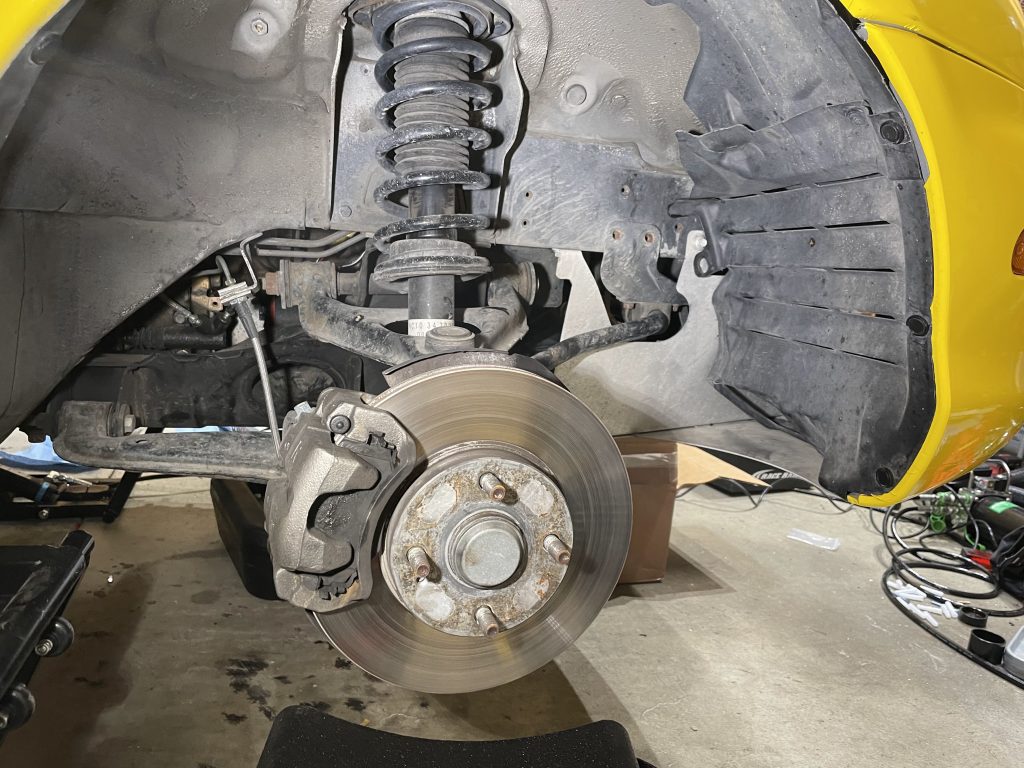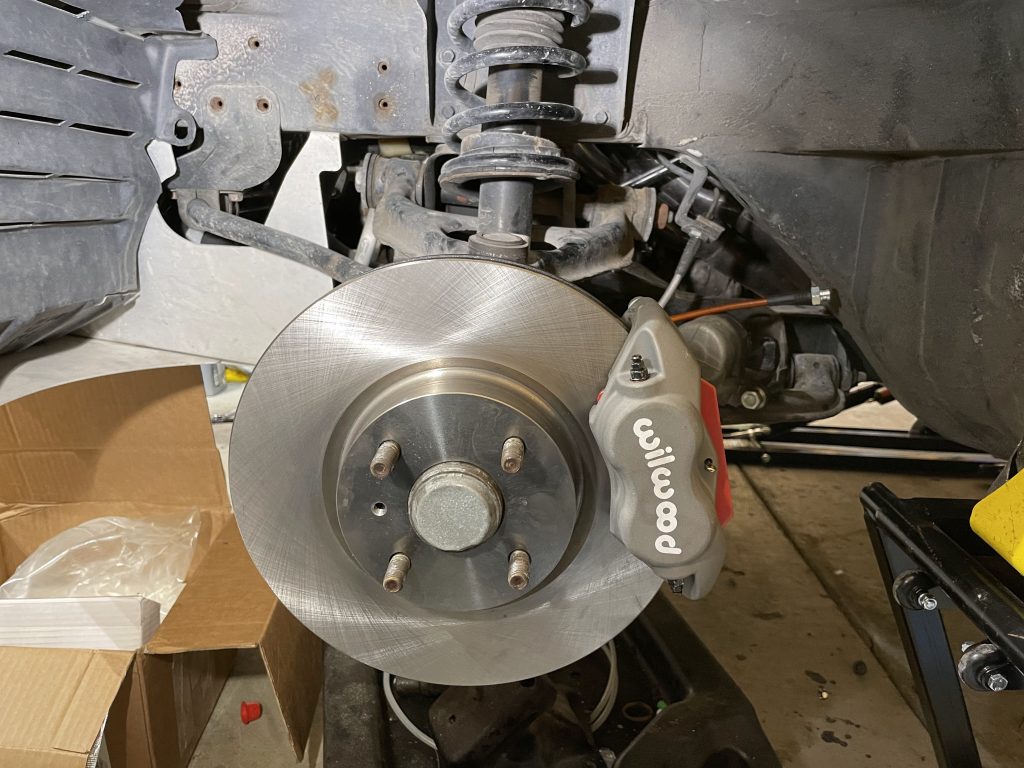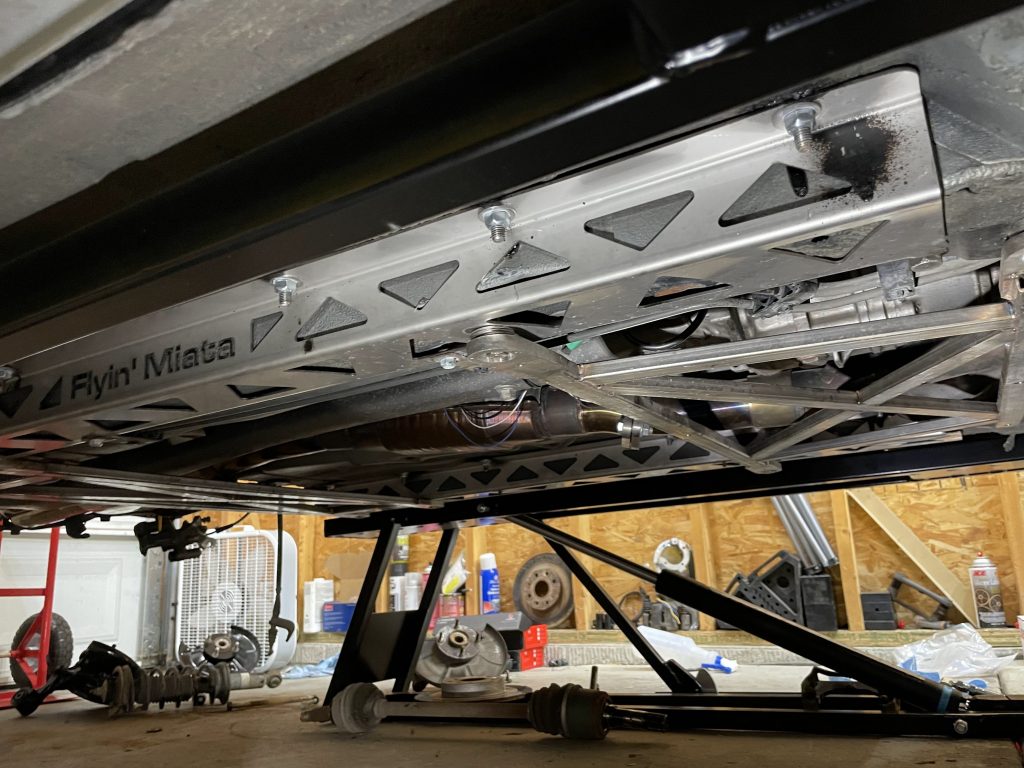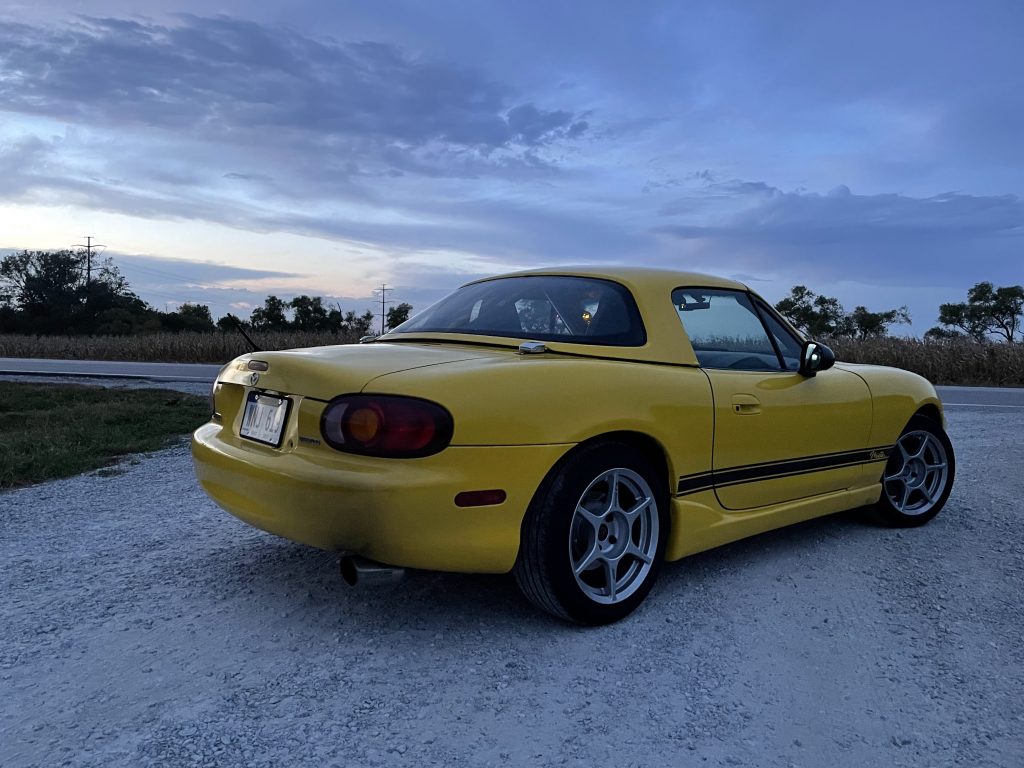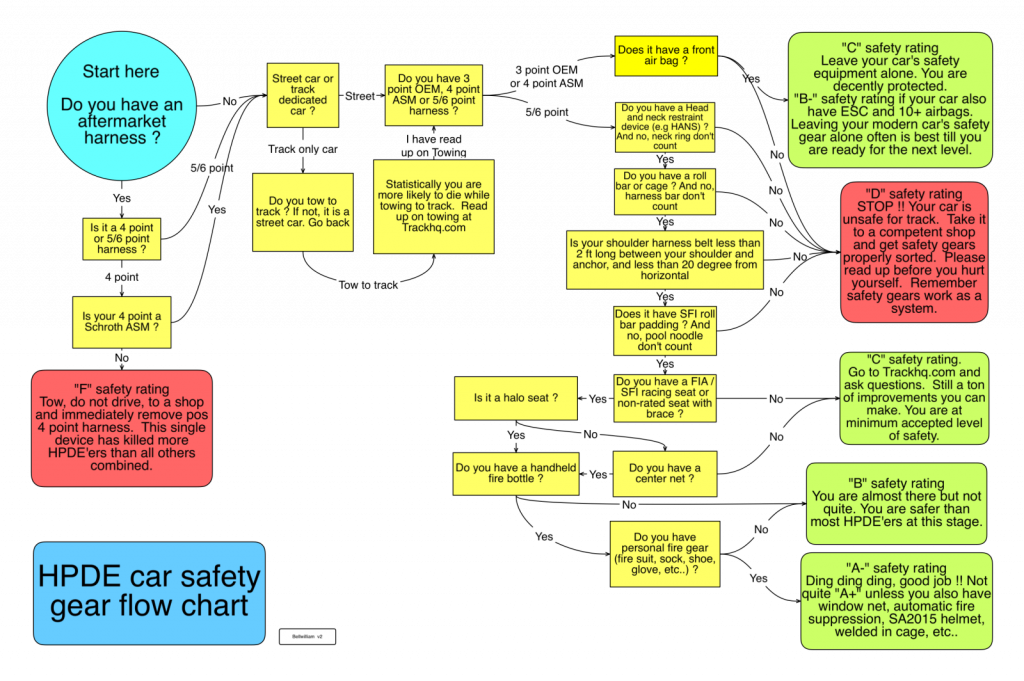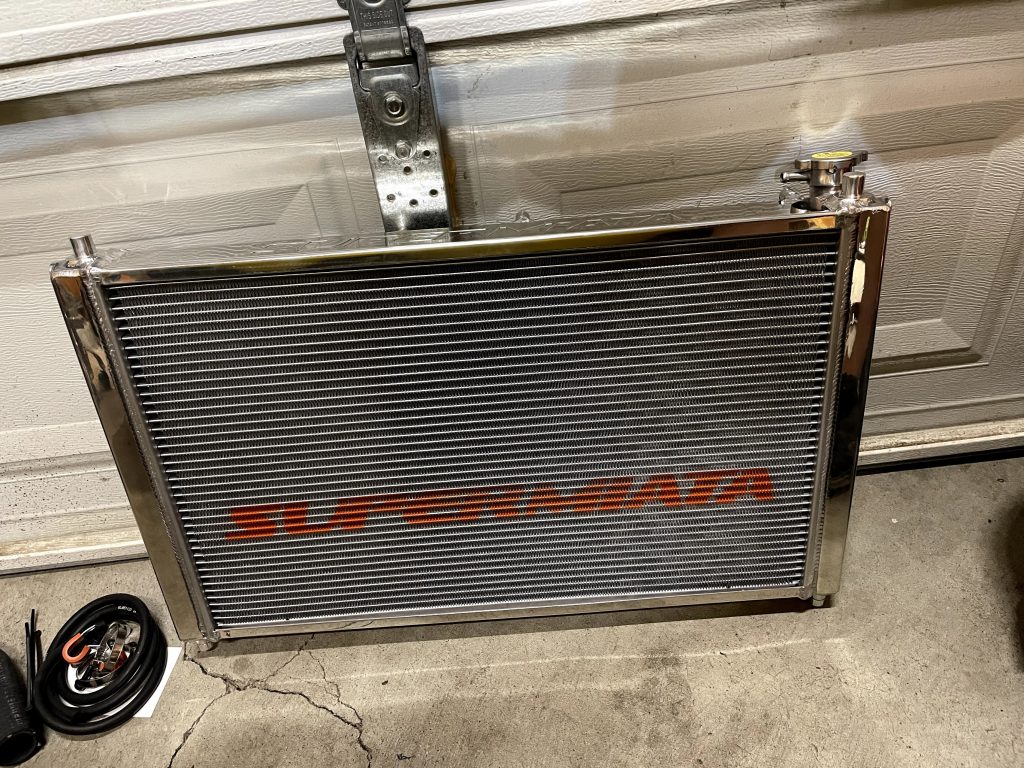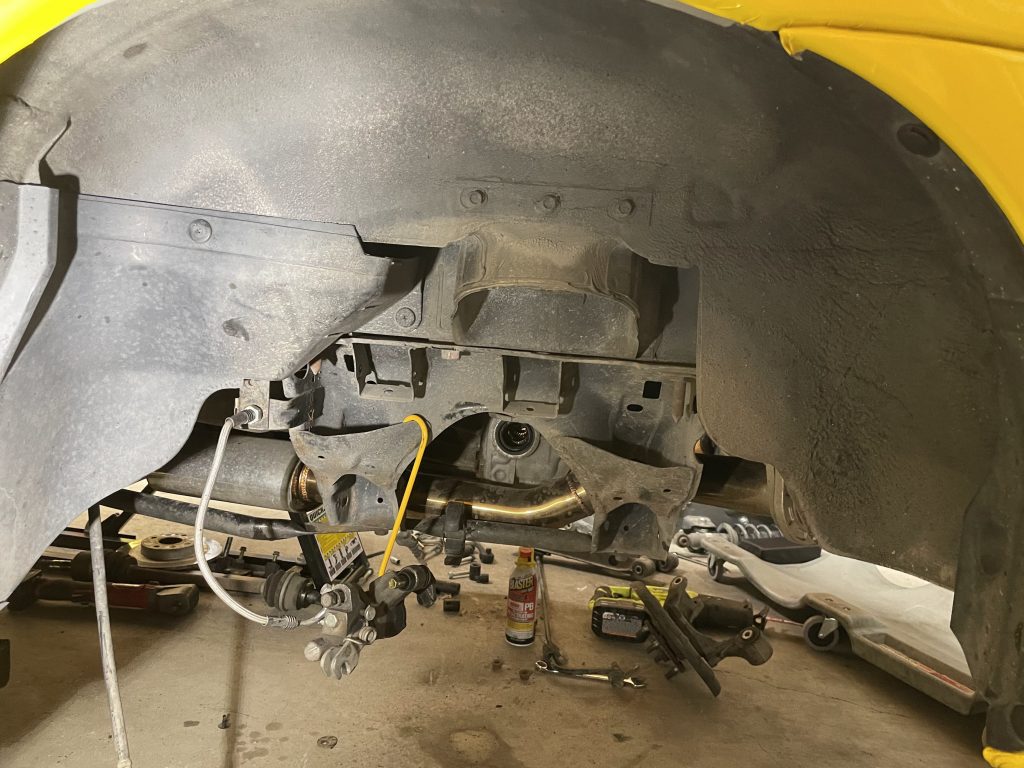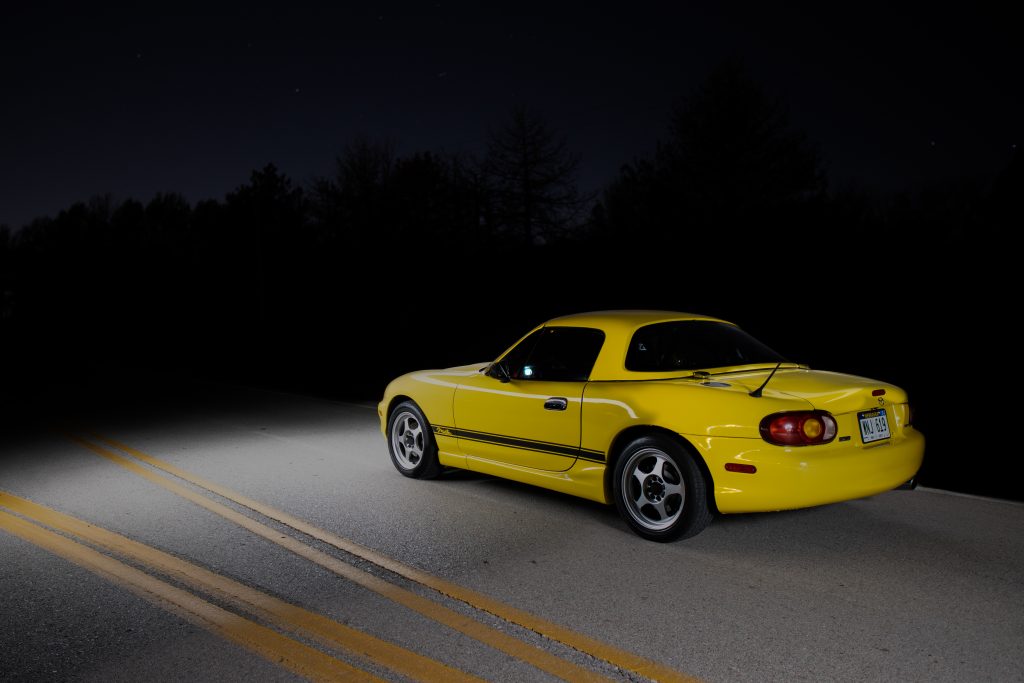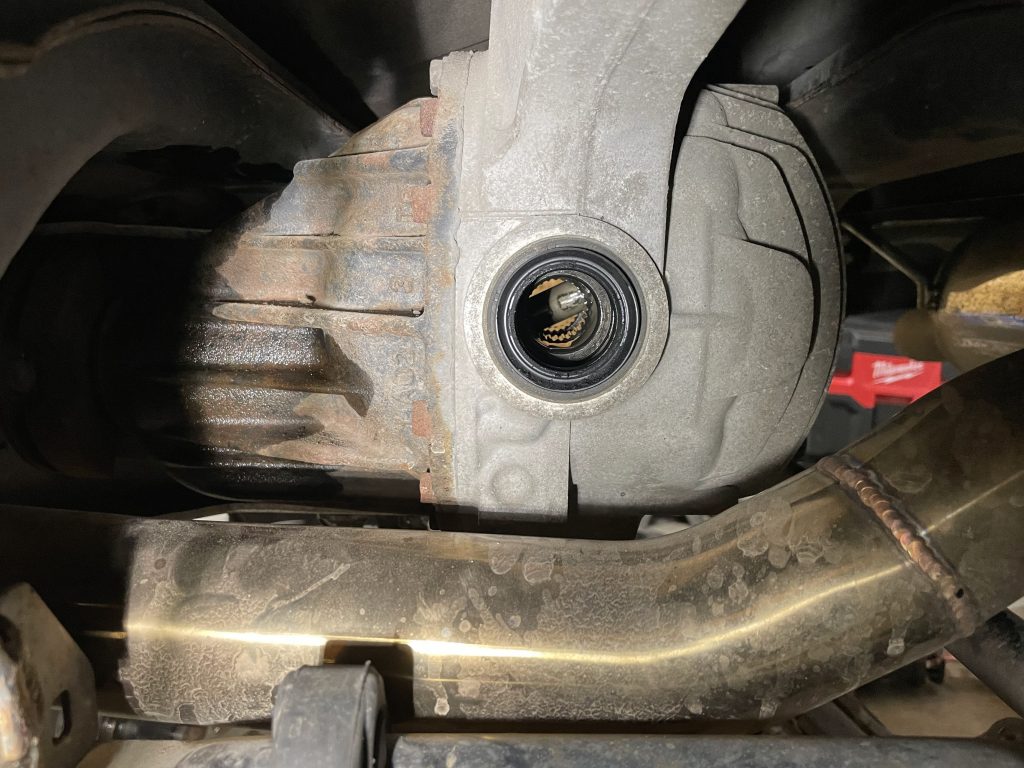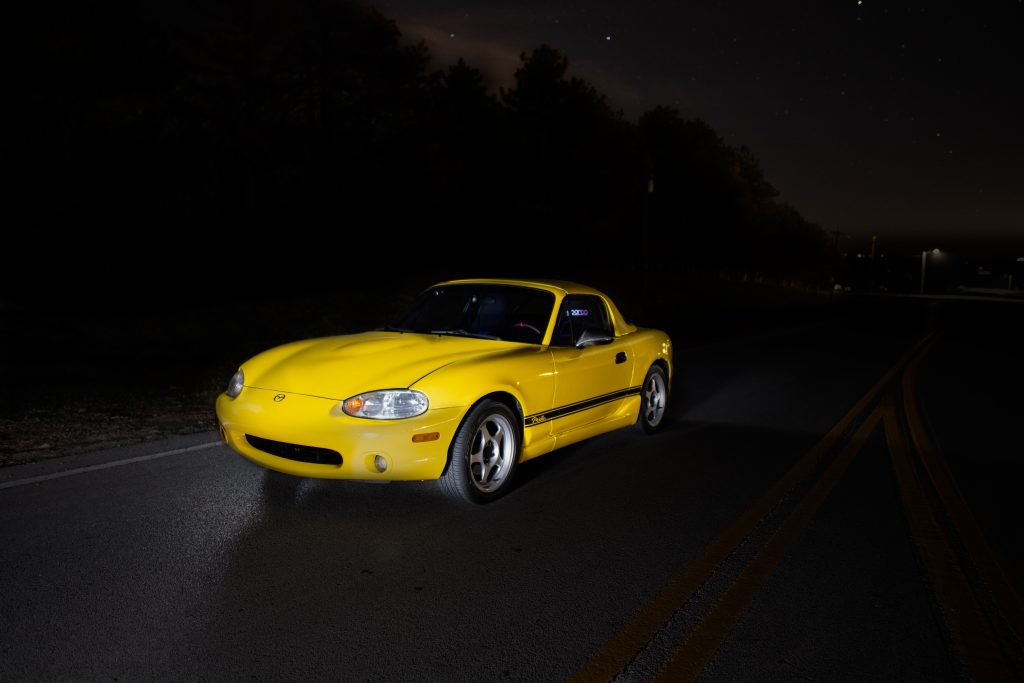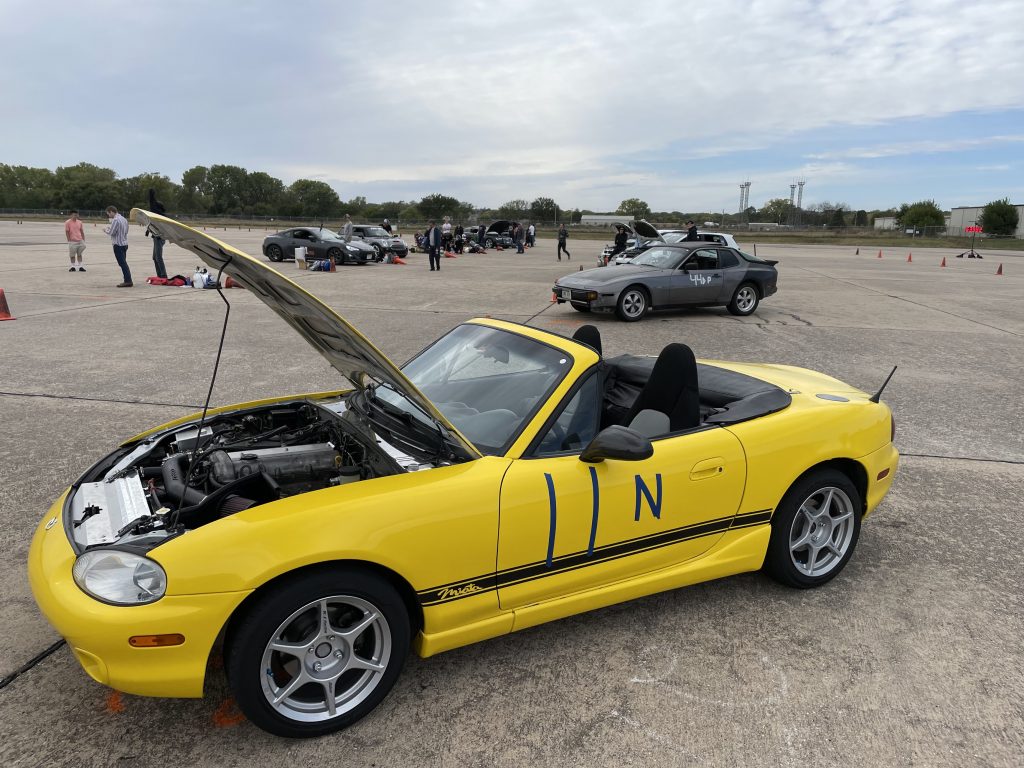NB Miata project – Future plans after six months of ownership
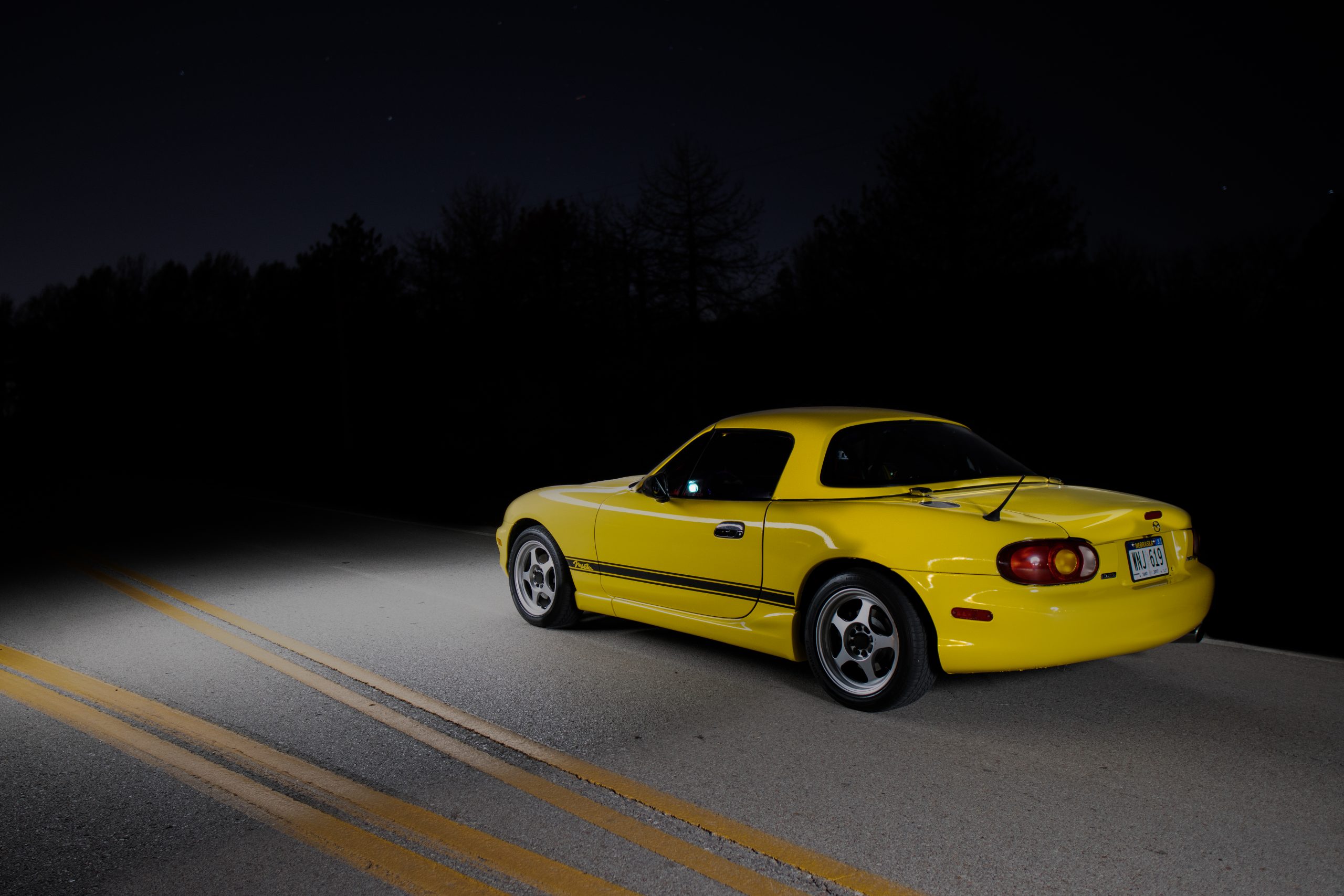
In my last several posts I covered my first six months of ownership of my NB Miata. This post focuses on what my future plans are for my Miata, mostly in the short term (the next six months), but also some thoughts on what I’d like to do longer term.
I had a lot of fun, and have done a lot to my Miata during the first six months of ownership. It has been a great car, and the mods I’ve done so far have already improved the car. My main priority for the next six months is to do what I can to better prepare my car for track days and autocrosses next summer. Things like the braking system, chassis bracing, safety, cooling, and suspension can be improved and allow me to have a better experience racing my Miata.
Braking system changes
The track day took quite a bit out of the more street comfort oriented brake pads I had installed. For whatever reason a couple of days later the pads stuck to the rotors. I was able to unstick them with a hammer, but some chunks had to be scraped off of the rotor. Before my second track day I did some things to improve braking performance.
- Replace street brake pads with StopTech Sport pads (seem to be a good balance of street usability + track performance).
- Replace rubber brake lines with braided stainless brake lines. The lines are fine, but the stainless may potentially give me a slightly better pedal feel, and if I’m bleeding the brakes anyways I might as well.
- Adjustable rear brake proportioning valve. This will allow me to adjust the amount of braking pressure sent to the rear brakes and could be a useful thing to mess around with (right now the front brakes have way more power than the rears).
- Brake fluid flush.
- Replace brake calipers. This isn’t really necessary, but then I’ll have an extra set if I ever have issues with what’s on the car.
Some time in the future I’m planning on rebuilding the brake calipers that were on the car already with an OEM rebuild kit. Then they’ll be ready to go if I ever have issues with the new calipers I installed.
Big brake kit
Even further down the road I may get a bigger brake kit. There are a lot of options. They should improve braking performance, make swapping pads slightly easier, and should improve braking feel consistency a little bit. Another big benefit of most big brake kits is a pretty big decrease in weight (of both the calipers and the rotors). That is all in addition to looking cool. I may also look into brake cooling ducting to improve brake cooling.
I didn’t really have any issues with the sport pads on the track, they seemed good enough for now. So the big brake kit won’t be coming anytime soon. I am still considering brake ducting in the near future, most likely taking air from the fog light holes (after removing the fog lights). Ducting should keep my brakes cooler and improve the longevity of the brakes, as well as allow me to have more braking performance for longer.
Chassis bracing and safety equipment
Installing Paco strong arms made a surprisingly big difference in how my Miata performed. Those Paco arms are just one of the many products available on the market that can improve the rigidity of the Miata chassis. I’d like to install some more of these parts in the near future to stiffen up my car to improve handling characteristics. Another somewhat related aspect I’d like to improve is the safety equipment in my car.
Frame rails + cross brace
After installing the Paco strong arms I am even more interested in additional chassis bracing. There are also frame rails and cross bracing that is available to improve the rigidity of the car. This bracing should improve the front to back and side to side stiffness of the whole car, while also giving me a convenient place to safely jack up the car at the frame rails.
At the time of writing this post I have actually already installed Flyin’ Miata frame rails + butterfly cross bracing. They were kind of a pain to install, but not too bad. I’ll most likely make another post about it in the future.
There is a lot of additional bracing I can do further down the road, but as it stands (frame rails, under fender bracing, cross bracing, and roll bar) my Miata no longer feels like a convertible. So that won’t really be as big of a focus anymore. I got my Miata to where I think it needs to be when it comes to rigidity.
Roll bar installation
A lot of tracks require roll bars for convertibles that don’t have any factory rollover protection, like the Miata. I ordered a Hard Dog M2 Sport with double diagonals, harness tabs, and padding with a cover. Since I drive the car on the street I sort of wanted to balance head impact risk with rollover protection, and the M2 Sport seemed to be a good balance. Combined with the NB2 seats I really don’t have a chance to hit my head on the bar. Of course this is at the expense of my head being at about the same level as the roll bar. A lower fixed back racing seat should allow me to sit lower if needed.
At this time of writing this post I have actually already installed the roll bar (it was delivered very recently). Installation was super easy, the fitment is perfect. I’ll most likely make another post about it in the future. I was really surprised at how much the roll bar improved the solidity of the back end of the car.
Fixed back racing seats
Race car safety is definitely a rabbit hole. It seems that it’s really a sort of all or nothing sort of thing for the most part. Keeping the stock seats, seatbelts, and airbags seems to really be the way to go unless you are really looking to get serious. I found a useful flow chart that basically explains how much you really need to do to be safer than the stock setup. There seems to be a sort of middle ground where certain DOT approved harnesses can be used with fixed racing seats and an airbag.
One of the things I noticed on the track was how I was putting a lot of effort into keeping my body in place around turns. With the stock seats I need to tightly hold the steering wheel and use the dead pedal to brace myself through hard turning. It works, but having to turn and brace yourself at the same time just isn’t ideal. I’d like to install some fixed back racing seats before my next track day.
Fixed back seats should hold me in place better on the track and allow me to focus on driving. Additionally with proper mounting I should be able to sit lower, which will be much safer in a rollover, and give me more headroom if I run with a hardtop. I most likely will try to run the stock seatbelts if possible, but consider harnesses in the future. These seats would be swapped in for track days, since the stock seats are perfect for the street.
Seat options
I thought I’d talk a little bit more about seats in this post. Getting seats into a Miata is tricky since you have limited room inside the car for them, especially once you install a roll bar. You also have to be careful and get a setup that sits low enough that your head isn’t above the roll bar. The key to Miata seats is finding something that is narrow enough, and low enough.
Stock Miata seats work pretty well on the street. They sit fairly low and are pretty comfortable. Where you run into issues is in the fact that they just aren’t very well bolstered, so they don’t really hold you in place. They also don’t have any way of supporting harnesses due to the seatback design. For me personally I have another issue where my NB2 seats aren’t low enough for me to use a helmet with a hardtop installed.
Here are some seats I’m considering. Ideally I’d like something that is comfortable and permanently installed (and compatible with the stock 3 point belt on the street). The passenger seat will also need to be big enough to fit a wide variety of passengers.
- Sparco Sprint: This is a super cheap FIA certified seat that can be mounted lower than the stock seats. It just barely fits in a Miata and may be a good option.
- Ultra Shield Rally Sport: This is an aluminum seat that can be mounted extremely low, and fits a Miata really well. An advantage of aluminum is that it can very easily be cut and bended to fit better. Padding can also be easily added under the cover for more comfort.
- Kirkey 65 Series: Another aluminum seat option.
- Marrad LX2: A seat specifically designed for Miatas that may be a good dual purpose seat.
Engine maintenance
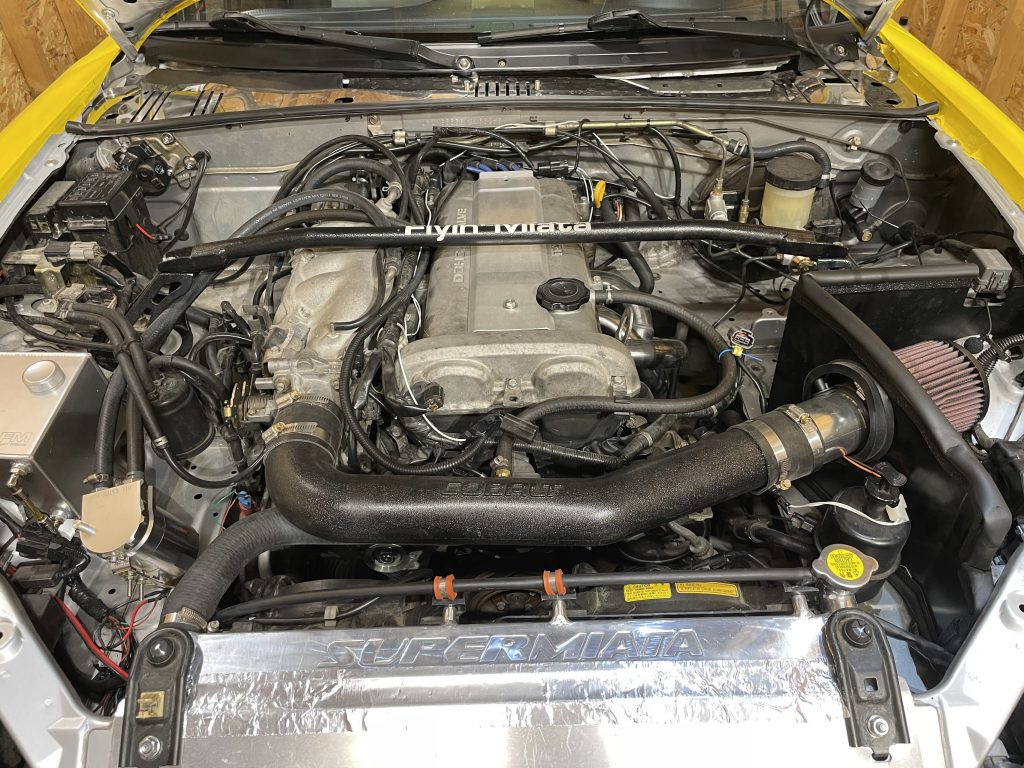 I spent a lot of time early on in my ownership doing preventative maintenance to bring my Miata up to a known good reliable state so I could enjoy it on the track. There are still some things I need to do that require a little bit more effort. I’d like to get these done over the winter when I’m not going to be driving the car. Some of these are more cosmetic, while some of them actually need to be done for longevity.
I spent a lot of time early on in my ownership doing preventative maintenance to bring my Miata up to a known good reliable state so I could enjoy it on the track. There are still some things I need to do that require a little bit more effort. I’d like to get these done over the winter when I’m not going to be driving the car. Some of these are more cosmetic, while some of them actually need to be done for longevity.
Polished valve cover
The Miata has a really nice looking engine bay from the factory. A lot of people paint their valve covers, but I think having a polished aluminum valve cover would really look the best in my car. I bought a spare valve cover that I’m in the process of polishing, and I’ll swap them when it’s ready. If the polishing doesn’t work out I can always paint it.
Intake manifold work + polishing
At some point I’d like to take off my intake manifold. From the looks of it the process is kind of a pain to do, so I’ve held off for now. There are a few reasons why I’d like to remove it. It mostly comes down to finishing the baselining process so I feel even more comfortable with the reliability of the car. I’ll most likely get this all done over the winter.
- Replace all of the intake manifold and throttle body gaskets, and give everything a good cleaning.
- Install freshly cleaned OEM fuel injectors.
- Replace any vacuum lines that may be hidden underneath the manifold.
- Replace the coolant lines that go to the oil cooler (they’re much easier to replace with the manifold off).
- Polish the intake manifold to match the valve cover (just like with the valve cover I bought a replacement that I’m in the process of polishing).
Engine out work
There are a few things I’d like to do that really are easiest with the engine out of the car. If it was just one of these things I probably would just leave the engine in the car, but doing all of this all at once with the engine out makes a lot of sense.
- Replace the leaking rear main seal.
- Replace the clutch, flywheel, pressure plate, throughout bearing (they are all fine as-is, but since all that needs to come apart to get to the rear main seal it makes sense to just replace it all).
- Install a new oil pan and oil pan gasket. I really don’t like having a stripped oil pan drain plug bolt, and replacing the pan would solve that issue and give me the opportunity to install a fresh gasket. The engine needs to be lifted a good amount to do this, so another reason to pull the engine out of the car.
- Do a coolant reroute. From what I’ve read the stock Miata cooling system isn’t optimal, since most of the flow happens through the front of the engine. Originally the engine was designed to be front wheel drive, but they moved the thermostat to the front of the engine to make it easier to access. For optimal flow the thermostat should be at the back so that cylinder #4 gets cooled better. It’s kind of a pain to install the reroute with the engine in the car due to firewall clearances, but it should be super easy with the engine out of the car.
Cooling system upgrades
My Miata didn’t have any overheating issues on the track, but my track days were also on cooler than average days. I’d really like to get my Miata to a point where I don’t even have to think about overheating. There are several improvements I can do to my cooling system that should allow me to run my Miata hard all day on the track on the hottest day in the summer. These are in addition to the coolant reroute mentioned in the last section.
Radiator upgrade
This is another thing that I’ve already done, but would like to mention it anyways since I didn’t have it when I wrote my performance upgrades post.
The stock radiator works fine, and doesn’t look like it’s going to break anytime soon, but an upgrade still may be worthwhile. My main concern is keeping the car cool on hot summer track days. I’m less concerned about coolant temperatures (which seem to always be fine), and am more concerned with oil temperatures. I have a feeling that upgrading the radiator and doing a coolant reroute may also reduce the oil temperatures by being able to keep the whole engine’s cooling system even closer to operating temperature all the time.
I ended up going with a SuperMiata cross flow radiator and keeping the stock fans. The radiator came with a higher pressure cap, but I kept the stock 1.1 bar cap to put less stress on the cooling system (I’m running regular antifreeze so I don’t really need to increase the boiling point like I would if I was running water). So far it has worked well, but didn’t really seem to improve my oil temperatures at all. When I’m driving the fans don’t need to run, the natural airflow through the radiator is enough. When I’m stopped the temperatures will rise, until the single fan turns on, and then things cool down and the fans stop, and the cycle repeats. Ducting may be useful to improve airflow through the radiator, but the stock fans seem to be good enough (even with AC).
Oil cooler
On the track, and when running at a higher RPM for an extended period of time like on the Interstate, results in elevated oil temperatures in my car. While they haven’t yet got to alarming levels, it is definitely something I sort of worry about. Will things get too hot at the track on a warm summer day? I’ll have to wait and see.
The first step in cooling I’ll do is installing an upgraded radiator, as well as doing the coolant reroute modification. That may give me a little bit more cooling that will be enough to keep oil temperatures in check. If it isn’t then I may need to look into installing an oil cooler. I don’t really like the idea of having oil lines since they are additional points of potential failure, but it may be necessary.
Installation of an oil cooler will require some work to figure out where to install it so that it can get airflow without interfering with other things like the radiator cooling. Right now I think I’d probably look at either installing it directly in the fog light area (after removing a fog light), or ducting some air from the fog light hole to the cooler.
Suspension refresh
For the most part I don’t find the stock Miata suspension as bad as people say it is. Yeah there is a decent amount of body roll, but once it rolls it stays planted. I’m more concerned about the overall age of everything. I can see some cracks in worn out bushings, and things like dampers degrade over time. Doing a full suspension refresh should really help my car going forward. Having a sorted suspension setup I like seems like what I need to do before worrying about things like adding more power.
Bushing replacement
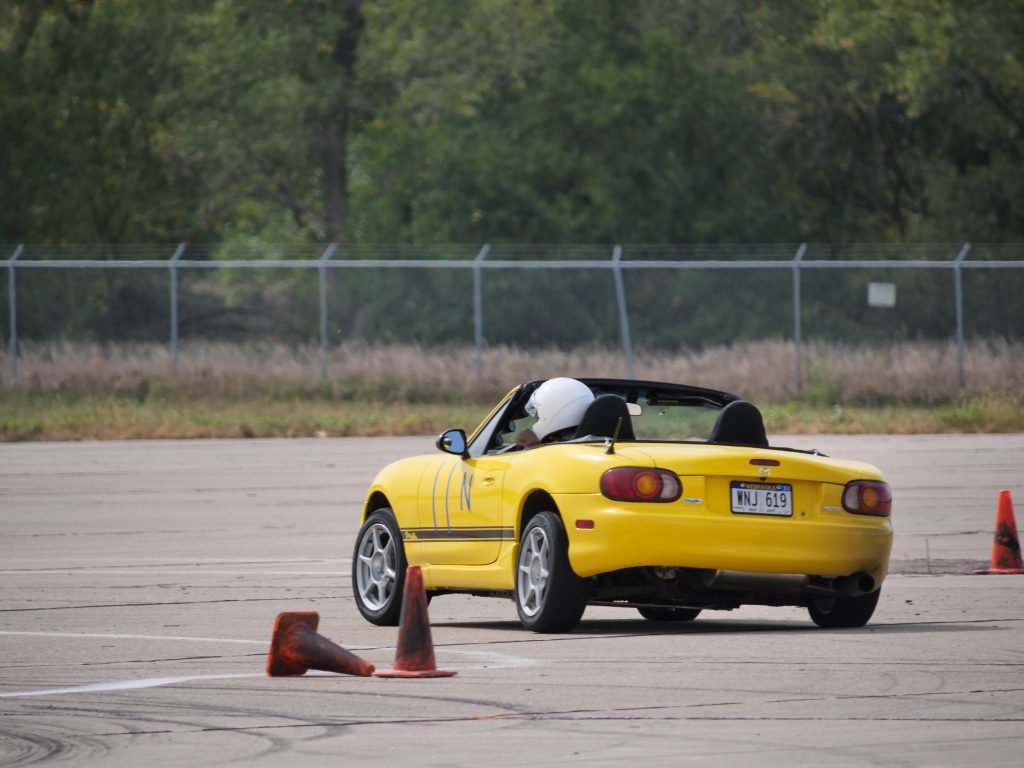
Photo credit: https://www.f64m.com/SCCA/NRSSCA-2021-10-10/i-XtzfKpX
My Miata is 21 years old so most of the suspension bushings on the car are in pretty rough shape. I can see cracks in some of them, so they definitely need replaced for optimal performance.
There are several options for bushings:
- OEM rubber bushings: These are what’s on the car now. Minimal harshness, long life, really the best option for a road car.
- Competition style rubber bushings: These are slightly stiffer than OEM rubber. They still work well on the street (minimal increase in harshness), but improve the handling feel of the car, and have great longevity.
- Poly bushings: Even stiffer. Probably one step too far for primarily street cars. You will get more harshness, and most likely hear squeaks when the suspension moves. Another big thing is that they need to be filled with grease. So you have to periodically deal with making sure your bushings are full of grease.
- Derlin bushings: Even stiffer than poly bushings. While poly is still a somewhat soft plastic, this Derlin is a hard plastic.
- Solid bushings: As stiff as you can get, basically metal on metal.
The bushings are pretty straightforward, I’m going to get the IL Motorsports competition style ones. My car is mostly a street car after all, poly bushings just don’t make sense for my use case.
Coilovers
The shocks/struts are a little more complicated. There seems to be an endless number of coilovers available for the Miata and deciding on what to get is really tricky. For the most part anything under about $1,000 seems to be basically Chinese junk, but beyond that price are some good options (Vmaxx, MeisterR ZetaCRD, Bilstein, Koni)
There are also some options that exist for a little more money ~$1,500. Like the Feal 441 and GoodWin Feal 441+, Fortune Auto 500, and MeisterR ClubRace.
For a little more are some “lower cost” high end options at ~$2,000. The Xida coilovers are in this class along with Flyin’ Miata Fox, Fortune Auto 510, Ohlins, MeisterR ClubRace GT1, Fat Cat Bilsteins, and some Penske configurations.
Beyond that are the real high end coilovers which are similar to the “lower cost” high end options but offer double and triple adjustable dampers. These are obviously way too expensive for me, considering some of them cost more than my car.
Part of me thinks I should just go with some DIY Bilsteins for the price to performance ratio. On the other hand it may be worthwhile to get something slightly higher end like the GoodWin Feal 441+ for the adjustable damping. Or I could just get Xida Race. The advantage of going high end is you buy the coilovers once and then you’re set forever, you really won’t need to upgrade down the road.
One of the disadvantages with a lot of the higher end coilovers that a lot of people don’t talk about is how they may not last as long as some of the cheaper options. Higher pressure gas and low friction dampers allow you to have a great suspension setup, but they just don’t have the longevity of something like a DIY Bilstein setup. They’ll need to be periodically rebuilt.
Sway bars
Sway bars are also an upgrade I can make. They are super cheap and easy to install, but I actually don’t mind the stock handling characteristics of the car. It has some body roll, and leans more towards understeer than oversteer for the most part. From what I’ve read sway bars can actually have a pretty drastic change on the handling characteristics of the car, so it may be worth doing some research and trying different setups.
Power adding mods
This post isn’t really in any particular order, but if it were this section would still be last. At this time I can still get plenty faster on the track and at autocross at my existing power level. Because of that adding power to my car isn’t really a high priority at the moment. At the end of the day the pick two of the following holds true: cheap, reliable, fast. If you want something reliable that can be driven hard on the track all the time it’s either going to be very expensive, or not not very fast. That being said there are some small things I can do in the near future to improve performance, and some big things I can do long term if I really feel the need for speed.
Standalone ECU
Installing a standalone ECU is pretty much necessary to make more power with a Miata. There are some workarounds, but really a standalone ECU is the best way to go about tuning an NA/NB Miata. Ideally I’d like to be able to tune my car myself, and tuning a pretty stock naturally aspirated car should be pretty straightforward. I can always find a tuner if things don’t work out.
Right now I have a standalone ECU but haven’t had the time to install it. Attempting to install it earlier in the year really made me appreciate what the factory ECU does. A factory ECU is setup to run well in pretty much all conditions, it can take a lot of work to get a standalone ECU to work as well as the factory ECU. Things like increasing or decreasing electrical loads, cold starts, warm starts, and abrupt throttle input changes, are all things that you need to tune to handle.
Installing the ECU is a lower priority for me right now. I’ll most likely get around to trying it again next spring or summer at the earliest. I should be able to get a small amount of power out of a proper tune, and then have a path to install additional power mods down the road.
Small naturally aspirated power mods
Once I have a working standalone ECU I’ll be able to do some things to get even more power out of my naturally aspirated car. Things like installing a better intake manifold, a bigger throttle body, and more aggressive cams. Of course these things won’t get me a ton of power, but when a car only makes 115rwhp every little bit counts.
Even installing the standalone ECU with my current setup should get me a decent bump in power through a good tune. The benefit of these small power mods and getting up into the 140+rwhp range is that you really aren’t sacrificing reliability to get there. All of the parts in the Miata are up to making that amount of power without any reliability issues.
Long term power mods
Even further down the road I may look into other things to increase power output. There are a lot of different directions I can go.
- Fully built naturally aspirated Miata motor. This isn’t really any cheaper than a turbo setup, and probably isn’t going to be making any more than 200rwhp, but it’s a unique way to go, and should be very reliable.
- Supercharged Miata motor. This isn’t super common either. There are kits that can make around 200rwhp out of a pretty much stock motor and they are fairly cheap. They don’t however go much higher than that like turbos do, so there is less room for power gains longer term. They also have the same sorts of reliability issues as turbos (lots of heat for example).
- Turbo Miata motor. There are several power levels here. Around 200rwhp can be done on a pretty much stock motor and for fairly cheap. It’ll require a little more effort to make it super reliable on the track though. 400+rwhp is also achievable if you are willing to spend a lot of money and do a lot of internal engine work.
- Honda K series swap. This is a way to get around 200rwhp out of a pretty much stock naturally aspirated reliable engine. Even more power is available if you want to turbocharge one of these.
- Honda J series swap: More power than a K series, while still being reliable and easy to find motors.
- Other engine swaps. People have done everything.
Right now I’m really leaning towards the Honda K series swap. They seem like a good reliable setup that will work well for track use, and seem to suit the Miata well. Around 200rwhp seems like a good step up from the stock power level. Realistically if I’m looking to get much more than that I think getting another car may be a better option (something like a Corvette for example). A lot of the Miata parts (like transmissions, differentials, and hubs) seem to become much more consumable as you crank up the power levels well past 200rwhp.
Does a dual duty street/track car make sense?
Building a car for both the street and the track can result in a car that is compromised for both purposes. For example a good track suspension setup is low and stiff, which doesn’t work quite as well for rough roads and inclines on the street. The same seats that hold you in so well on the track aren’t generally going to be super comfortable on the street, and can be a pain to get into and out of. A lot of racing seats have head containment pieces that hold your head in place, but prevent you from being able to look over your shoulder on the street.
Right now I’m building a car for both the street and the track which may not actually make the most sense. At some point it may make more sense to get a second car so I have a dedicated track car and a dedicated fun street car. A dedicated track car opens up a whole lot of cool things I can do that just don’t make a ton of sense on the street. For example at some point I may want to do some aerodynamic mods (things like splitters don’t always work so well on the street).
Another consideration is car classing. A lot of mods will push your car into a class that you won’t really be able to be competitive in. So I may need to be careful with how I build a possible future race car.
Conclusion
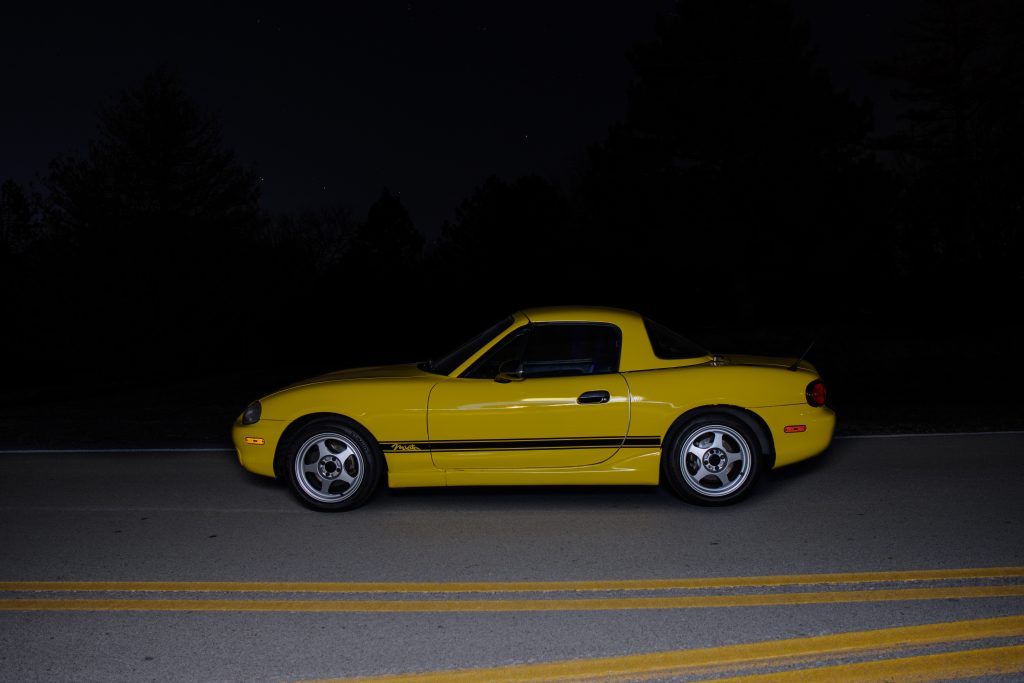
I had a ton of fun with my Miata during my first six months of ownership. At the time of this post publishing I’m a little over eight months of ownership, and I just put it away for the winter. I look forward to working on my Miata over the winter so that it’s even more ready for next year and beyond. In 2022 I plan on racing it a lot more (both autocross and HPDE). I plan on driving it on at least one new race track in addition to the track I went to this year.
